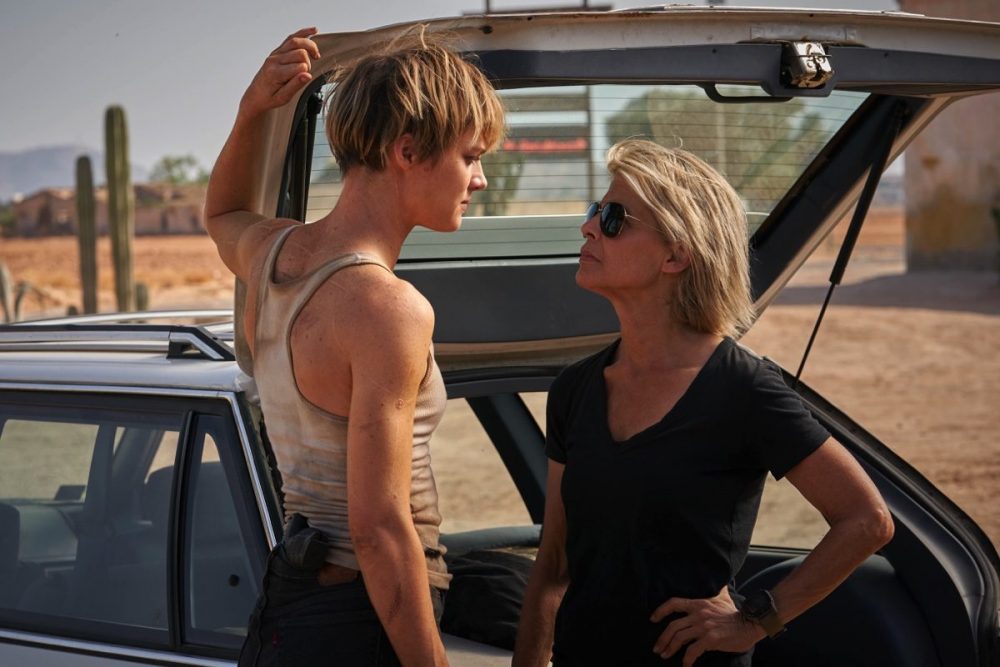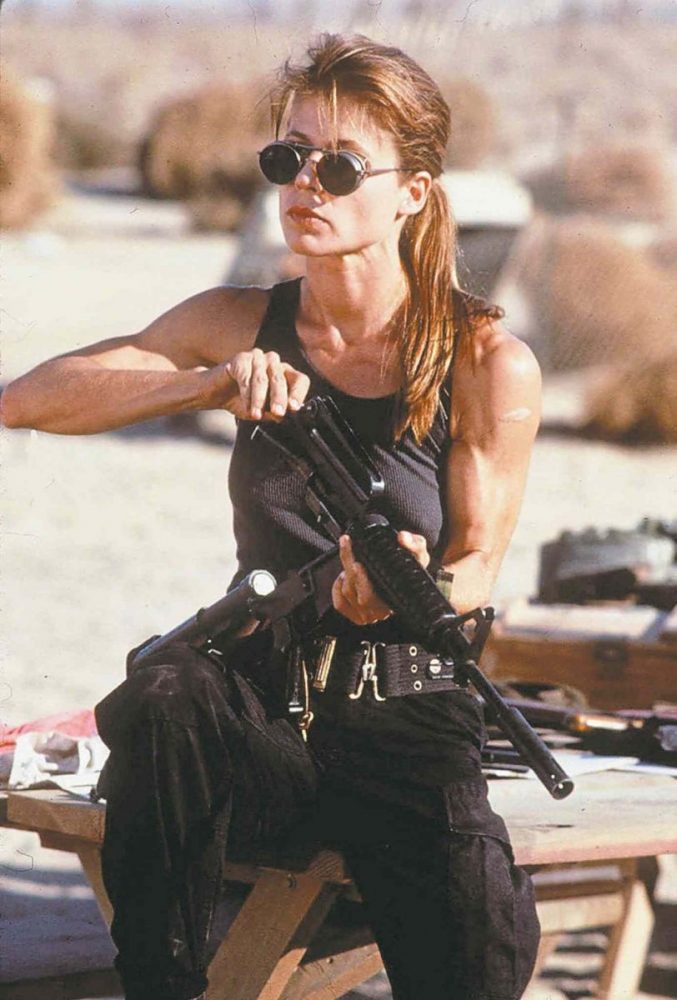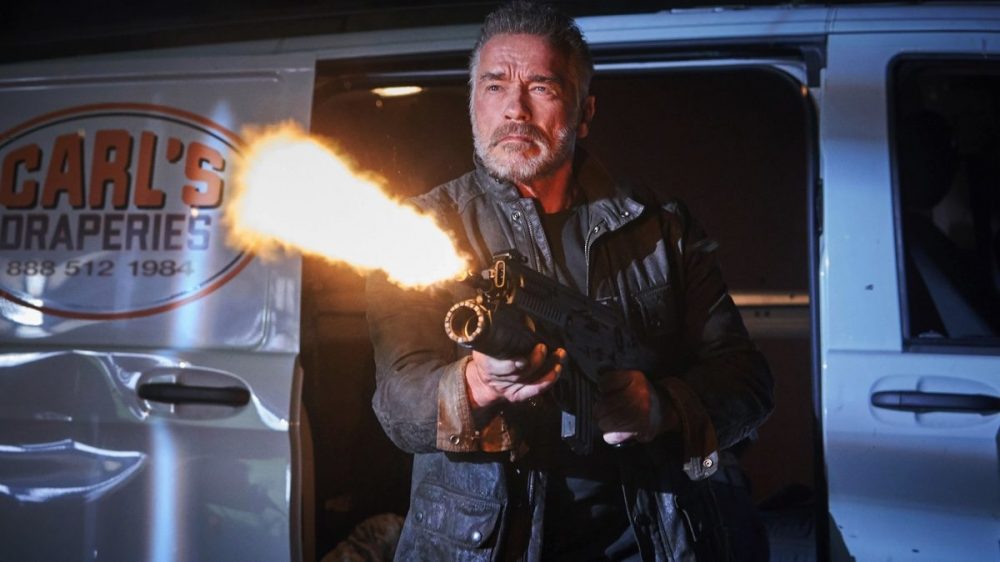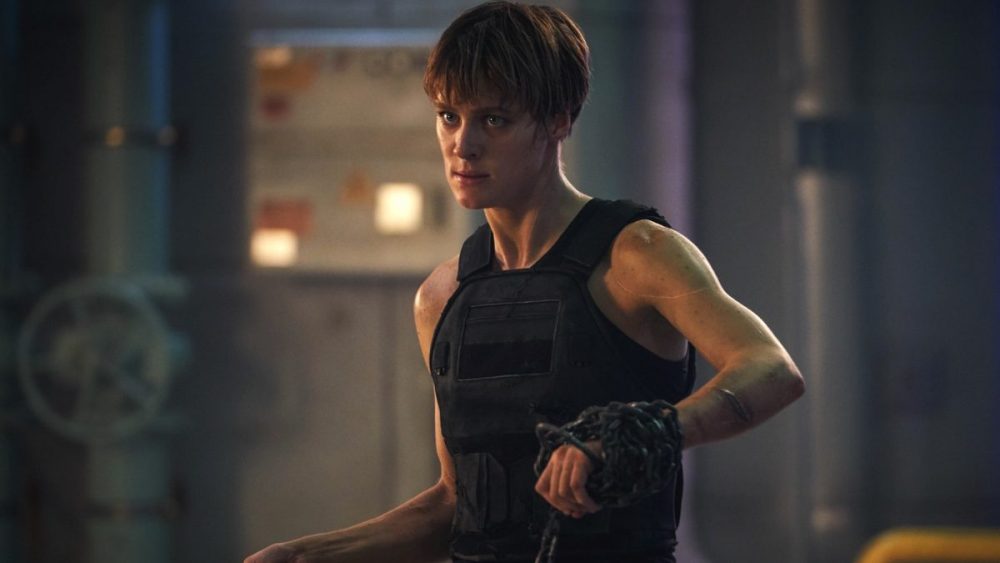Screen icon Linda Hamilton is back as Sarah Connor in Terminator, Dark Fate.
It’s been 28 years since we’ve seen Sarah Connor on the big screen, and her return is an event.
So much so that James Cameron produced and story-supervised the $185 million reboot, Terminator: Dark Fate, essentially to resolve her character arc (which began in the 1984 original, The Terminator and continued with 1991’s Terminator 2: Judgment Day) and to deliver the franchise to a new generation.
The night I saw Terminator: Dark Fate in an IMAX in Times Square, New York, the cinema was at capacity. Most everyone was younger than me, of a different color than me, but when Sarah Connor made her entrance, her military boot hitting the highway as she gets out of her car, machine gun at the ready, the entire audience cheered.
But it made me wonder: where did their knowledge of Sarah Connor come from? She’s been gone for almost three decades and yet they all recognized her instantly and anticipated her function in the new narrative as truth, strength, revenge. Digital media has all but killed off archetypes. Long live archetypes.
And if you’re a digital native who is wondering what an archetype is, awash as we are these days in a multiplicity of simulacra: an archetype is the essential original that is often imitated for symbolic value. Which is to say, analog has its place.
Remember in Terminator 2: Judgment Day when Sarah Connor is doing chin-ups, a vision of essential female strength? When she’s stripped down to muscle and sinew, a cigarette hanging from her lips as she arms up? That was 1991. There were no iPhones, no Alexa, no Amazon. I’m so glad she’s back for the #MeToo generation who didn’t catch her the first time around.
And so to Terminator: Dark Fate. When the credits to this non-stop, action-packed, thoroughly enjoyable feature rolled, a teen male sitting behind me said with a tone of awe, “I’d bang that old-ass lady Sarah Connor!”
Bless. And: He’s not the only one.
This installment of the sci-fi/action franchise is all Linda Hamilton’s—even if you didn’t know her from before. Since almost no one in the audience was old enough to have seen the original or even possibly its sequels, I wondered out loud to Linda Hamilton, who I was lucky enough to snag a few precious minutes with, how the legend of Sarah Connor had captured their imaginations.
Hamilton, 63, didn’t really know, either. When I speak to her about the film she is more interested in discussing its themes than whether her comeback is a commercial success. “I really don’t do much projecting about who it’s going to reach or who’s going to like it because that’s standing outside of yourself. I just sort of plug in and plunge in and do it without much thought to how people are going to receive it.

“I think that’s kept me kind of honest my entire career because I don’t do it for box office. I really just like to stay in the moment, do my job, I keep it really simple for the most part. I decided years ago that my job is to make the director happy. One person. And then that’s our relationship. I don’t really ask a lot of questions. I just do it.”
There’s something analog abut Linda Hamilton. As in, you had to be there. Not her avatar. Her. She turns up. She gives her all. Although she’s previously stated that she isn’t much like Sarah Connor in real life, Hamilton radiates strength, intelligence, instinct. So, in fact, a little like the woman who saves the human race only to trigger a time loop where she has to do it all over again. Hamilton declined to appear in a third Terminator movie when she judged the part to be poorly written and repetitive. Sarah Connor is iconic—she deserved better. She’s one of only a handful of action heroine outliers: like Jamie Lee Curtis as Laurie Strode in Halloween or Sigourney Weaver as Ellen Ripley in Aliens. They only come along a few times in a century.


Hamilton was 61 when she was offered the part in Terminator: Dark Fate “and the fact that it was [ex-husband] Jim Cameron who brought it to me — I was just shocked,” she says. “Never did I see that coming, that they would offer it to me at this age, really. I hesitated for quite a long time, giving it thought, picturing it, what I could bring as a woman of a certain age, and then I finally decided to jump in. I was a bit terrified. I didn’t want to let Sarah Connor down.”
And she doesn’t. She got herself back into military-grade shape and reacquainted herself with an arsenal of weapons—all of which she expertly handles. She’s the biggest badass and she has some terrific moments including the co-opting of Arnie’s former tagline, “I’ll be back.”
I understand the pressure Hamilton must have felt. Sarah Connor is an archetypal role, a Mary-mother-of-Christ figure who ends up saving three billion lives in a war against machines only to have the machines rise again. But this time, her archetype has become enriched. She’s part of a triumvirate of women who must work together and save the world.
“You are really using language that I use: the triumvirate, and I always think of John Connor as Jesus because he saves mankind, and very much in the first film I was Mary,” Hamilton tells me. “I make these kinds of relationships for myself just to get a certain understanding of where I fit in a story. And in the second film, I was John the Baptist, the voice crying in the wilderness.” Indeed she was. Remember the scene in T2, in the therapist’s office where she’s telling the story of how she was committed to an insane asylum for trying to warn people about the rise of the machines?
“This time I’m Lazarus, back from the dead,” she laughs. “And truly, she’s so dead inside, there’s nothing left but a brittle core of anger and vengeance.”
This time, we meet Sarah Connor still powerful, but living like a renegade, a hermit, hiding her cell phone in a foil chip bag so the machines can’t track her down. She confesses that she frequently drinks until she blacks out. Her grief over the murder of her son has turned into white-hot vengeance. But then she meets two other women.


The sisterhood. The film opens in Mexico with the characters speaking Spanish, and the central character, Dani, is being pursued by a terminator from the future. Pursuing him is an enhanced human soldier, Grace.
Dani must follow her quest in the US and so she becomes an illegal immigrant. Caught at the border, Grace frees her—along with other immigrants locked in cages— and it’s a stirring moment. Immigrants are people, too. Women can be legitimate action heroes. And Sarah decides she has to get over herself and backs up Grace so that Dani can be delivered into her rightful future.
Because Hamilton avoids watching herself onscreen, she tells me she was unlikely to see this film. But now she says she will see it for her girls. “I’m just such a fan of the women that I work with in the film, Natalia and Mackenzie. I just I owe it to them.”
As for the film itself? Okay, so maybe I couldn’t work out the metaphysics of the time loops between 1997, 2042, and now, but I’m not sure it matters. This is the best Terminator film since Terminator: Judgment Day. Directed by Tim Miller (Deadpool) this film is both grim and funny, with white knuckle chase sequences, solid fight scenes, and even a tender and comic subplot involving Arnold Schwarzenegger who plays the retired Terminator, now known as Carl—posing as a human and living in the woods with a wife, a son and a drapery business. Don’t ask why, just go with it.

While Connor wants to kill him (for killing her son, John), he just wants to help her. His feminization, and the complete excision of John from the plot, is part of the film’s centering of women. Sarah Connor, Grace (Mackenzie Davis) and Dani (Natalia Reyes) make up the new triumvirate of female action heroes and this time it’s up to them to save the human race. They are being chased by the newest model of terminator—a Rev-9 (Gabriel Luna)—who seems frighteningly indestructible and won’t quit until Dani is dead. To me, he posed the idea of everything that Silicon Valley has told us is essential and now we can’t get rid of any of it. It’s leaked into our lives and we are beholden to accepting the next upgrade, whether we like it or not.
It’s no accident that enhanced super solider, Grace, is human but has had imposed upon her machine components that end up making her sacrificial—heads up, though: the climactic scenes between Grace and Dani have an undeniable lesbian subtext.

The film’s actual message, says Hamilton, is a warning. “I believe that it is a true cautionary tale that is obviously more relevant today than it was in ’84. My relationship to technology is almost nil. I don’t even have a computer,” she reveals. “Forget about AI taking over our lives. We’re creating a world in which we get weaker and weaker because we now have machines to do everything for us. We don’t have to stand up to turn the lights on and off and evolution is based on the survival of the fittest, not the smartest. The more help one has, the weaker one gets.”
But Hamilton, who lives in New Orleans and spends “very little time thinking about what other people think of me, which is a very healthy place to be in, especially as a movie star,” is perhaps again more like her Terminator character than she knows. But in a good way. I ask her if she’s aware that a lot of lesbians are huge admirers, both of Sarah Connor and of her character, Catherine, in Beauty and the Beast who offered up a well of expressivity, episode after episode, in love as she was with a leonine “beast” named Vincent. Of that series she says, “I sure did do a lot of crying.” And Hamilton has always said that tough-as-nails Sarah Connor is not who she is; but when she spoke candidly 15 years ago about being diagnosed with bipolar disorder and treating it, perhaps her most meaningful intersection with Sarah Connor.
I ask her why she thinks so many lesbians have followed her career and admire her work.
“Perhaps because I’m a strong woman and one of the first women to kick ass.”
I would entirely agree.
“But you know within that I’m just a whole person,” she says. “Not just a caricature. A full-blooded woman.”
And of course, there it is: Hamilton’s humanity is thoroughly appealing to other women. And, of course, to the guy sitting behind me in the Times Square IMAX.
When I exited the theater and headed for the subway through the dystopian mess that is Times Square, I looked suspiciously at my AirProds before popping them into my ears and realizing that I am, already, at least part cyborg, hopelessly reliant on machine parts that I neither know how they were made or what I would do without them.
It’s time for Sarah Connor.
